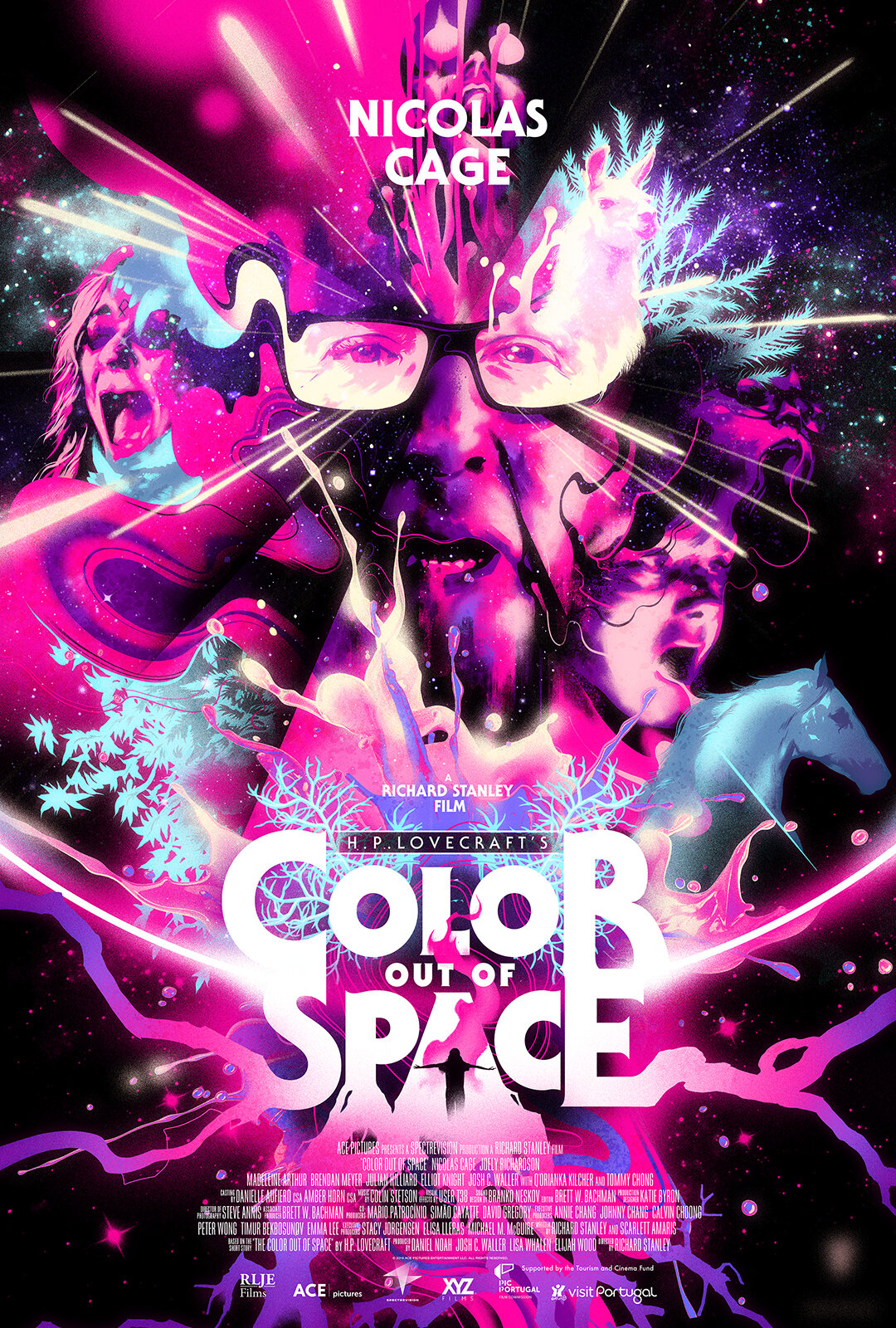Malaysia/Portugal/US | 2019 | Directed by Richard Stanley
Logline: A secluded farm is struck by a strange meteorite which has apocalyptic consequences for the family living there and possibly the world.
It’s been a long time between spells, but Richard Stanley is back in the feature director’s chair and all is good in the cosmos once again. Or maybe not. As Stanley tackles the big conceptual boots of H. P. Lovecraft and all that deep cosmic dread the author is synonymous with, he brings to vivid life a fresh take on the short story “The Colour Out of Space”, written in 1927. It was Lovecraft’s personal favourite of his short stories, and has been adapted for the screen several times, but nothing as vivid, confrontational and epic as Stanley’s.
Nathan Gardner (Nicolas Cage) has moved his family, wife Theresa (Joely Richardson), teenage daughter Lavinia (Madeleine Arthur) and son Benny (Brendan Meyer) and their kid brother Jack (Julian Hilliard), to a rural farm (in Lovecraft’s fictional township of Arkham) to start afresh. Whilst Theresa deals with cancer recovery, Lavinia has turned to Wicca to entice white witch positivity, and Nathan has taken several alpacas under the family hood, an effort to foresee the future of farming.
A hydrologist Ward (Elliot Knight) is camping in the area when an electrical storm brings a meteorite crashing into their yard. He investigates, along with the county Sheriff. Ward discovers the groundwater is tainted and advises the Gardner family not to drink it. The Sheriff isn’t interested in doing anything radical, as it will impact on the dam development. But there are more pressing developments afoot …
Stanley co-wrote the screenplay with Scarlett Amaris, whom he collaborated with on the segment he directed for The Theatre Bizarre anthology. They move the narrative swiftly, and it isn’t long before the colour out of space is doing very unnatural things on terra firma. Theresa is already under duress, and her distraction leads to injury. Jack is mesmerised by the bright hues emanating from around the yard well, which is where it appears the entity that arrived with the meteorite is holding fort. Nathan’s tumbler of bourbon on the rocks isn’t going to help him deal with his wife’s nasty accident and the children’s subsequent misbehavior. Keep in mind, the ice cubes aren’t what they used to be …
Performances and production values are all excellent (I’m reminded of Rob Bottin’s special effects makeup work in The Thing), but one of the strongest structures to Stanley’s adaptation is how he seriously he treats the most absurd and fantastical elements. Okay, so Nicolas Cage does go Full Cage in a couple of scenes, although nothing like his performance in Mandy (which totally suited that movie, but I digress …), but Cage’s OTT behaviour - with his unique vocal inflections - doesn’t actually seem out of place in this movie either. This is a family that are being infected by an alien organism that is beyond anything we can rationalise, everyone’s reacting differently, dealing with their own crazy, even Ezra (Thomas Chong), the hippie living at the end of the property.
One of the key points of the original story was that Lovecraft was particularly interested in creating a truly extraterrestrial being, something that would be virtually impossible for human kind to deal with, utterly outside the human experience (a concept I’ve entertained since I was a lad). The colour itself is never identified, beyond the spectrum we recognise, but is portrayed in the movie with shifting hues of bright, mostly primary colours, but in particular, a shade of mesmerising electric violet.
The diseased land and the poor creatures - humans included - that dwell upon the tainted earth become more drastically infected/affected, with an especially horrendous outcome for mother and son. It’s as if the alien entity is both feeding upon and struggling to adapt to the strange planet it’s landed on. I’m reminded of two superb adaptations, Alex Garland’s Annihilation, based on Jeff VanderMeer’s novel, and Andrei Tarvosksy’s Solaris, based on the novel by Stanislaw Lem. Both dealing with a powerful alien entity and how it transforms and how it affects the lifeforms that come into contact with it.
With Color Out Of Space the consequences are grim and unknowing in the best possible way that science fiction horror can deliver. The crater in the Gardner’s yard and home was just the tip of the cosmic tendrils.
And now they’ve become roots.






